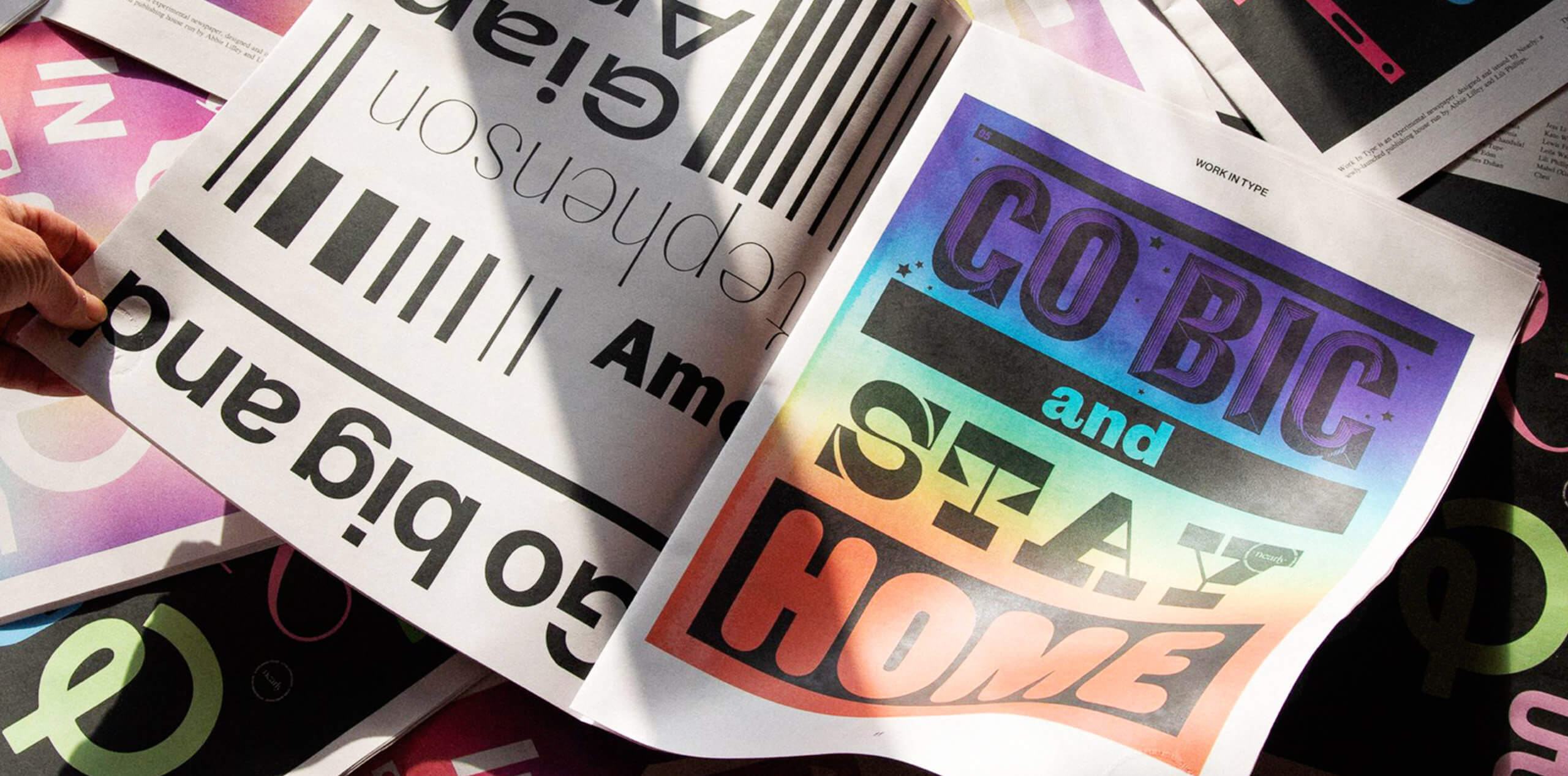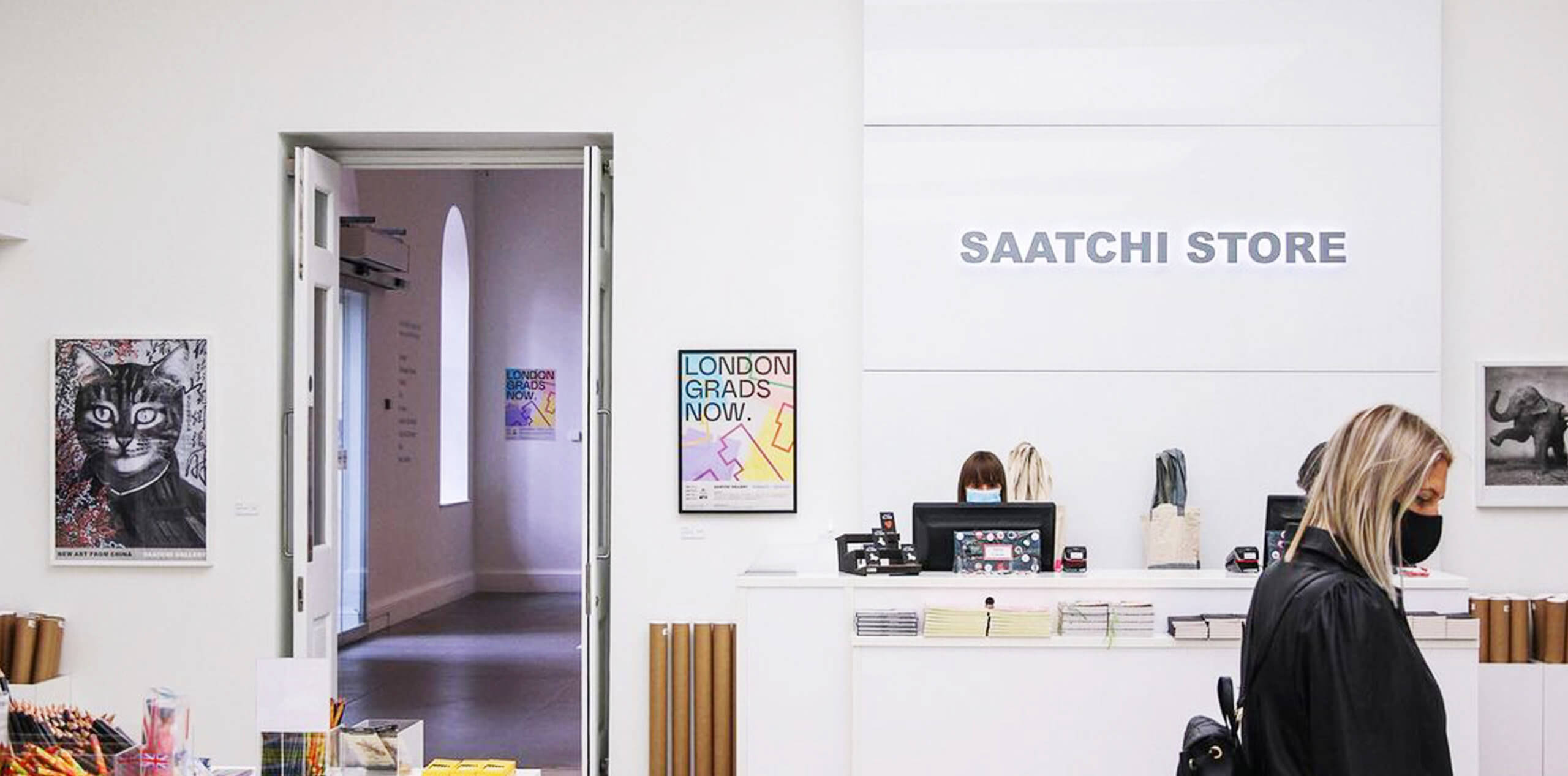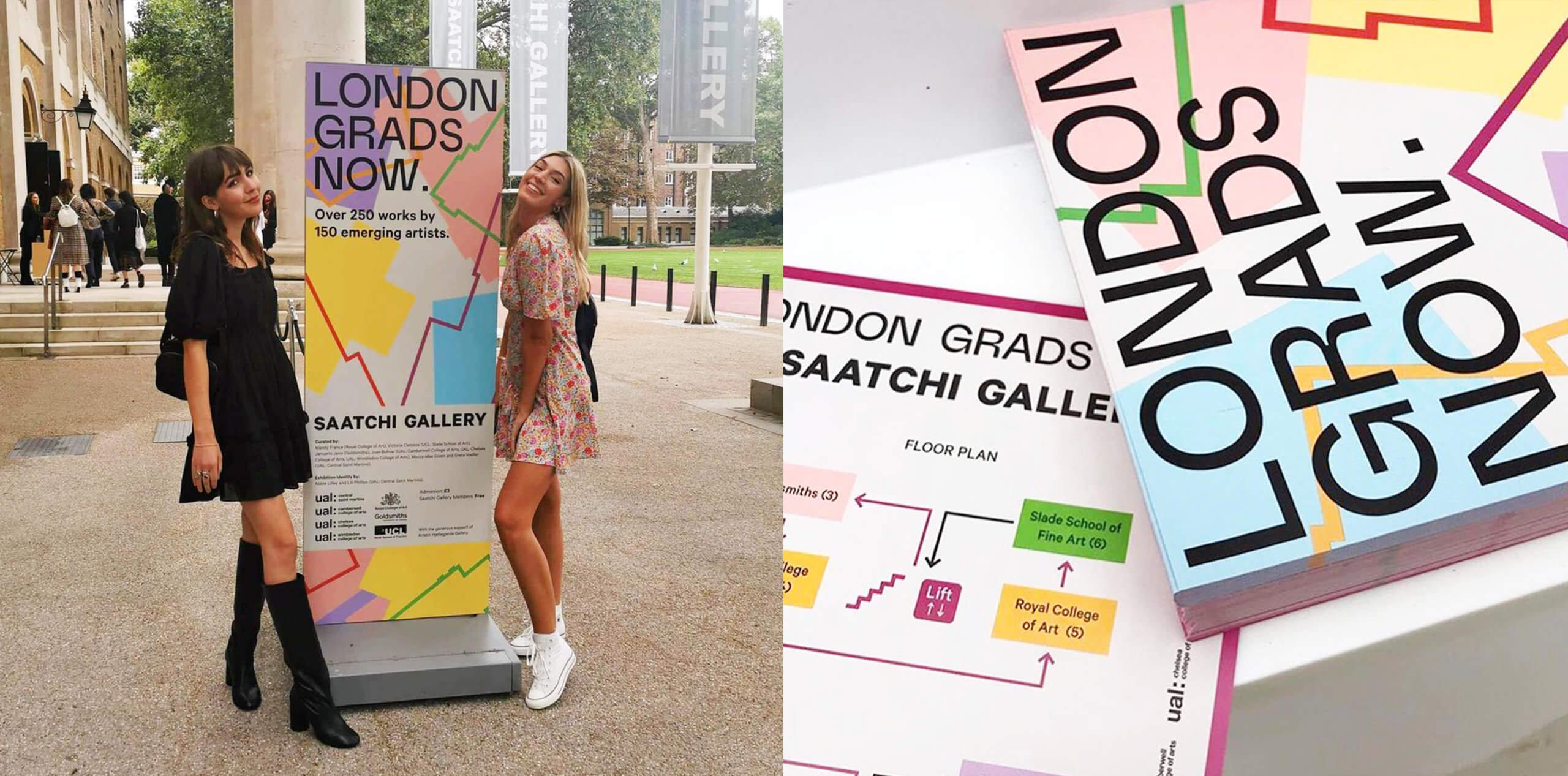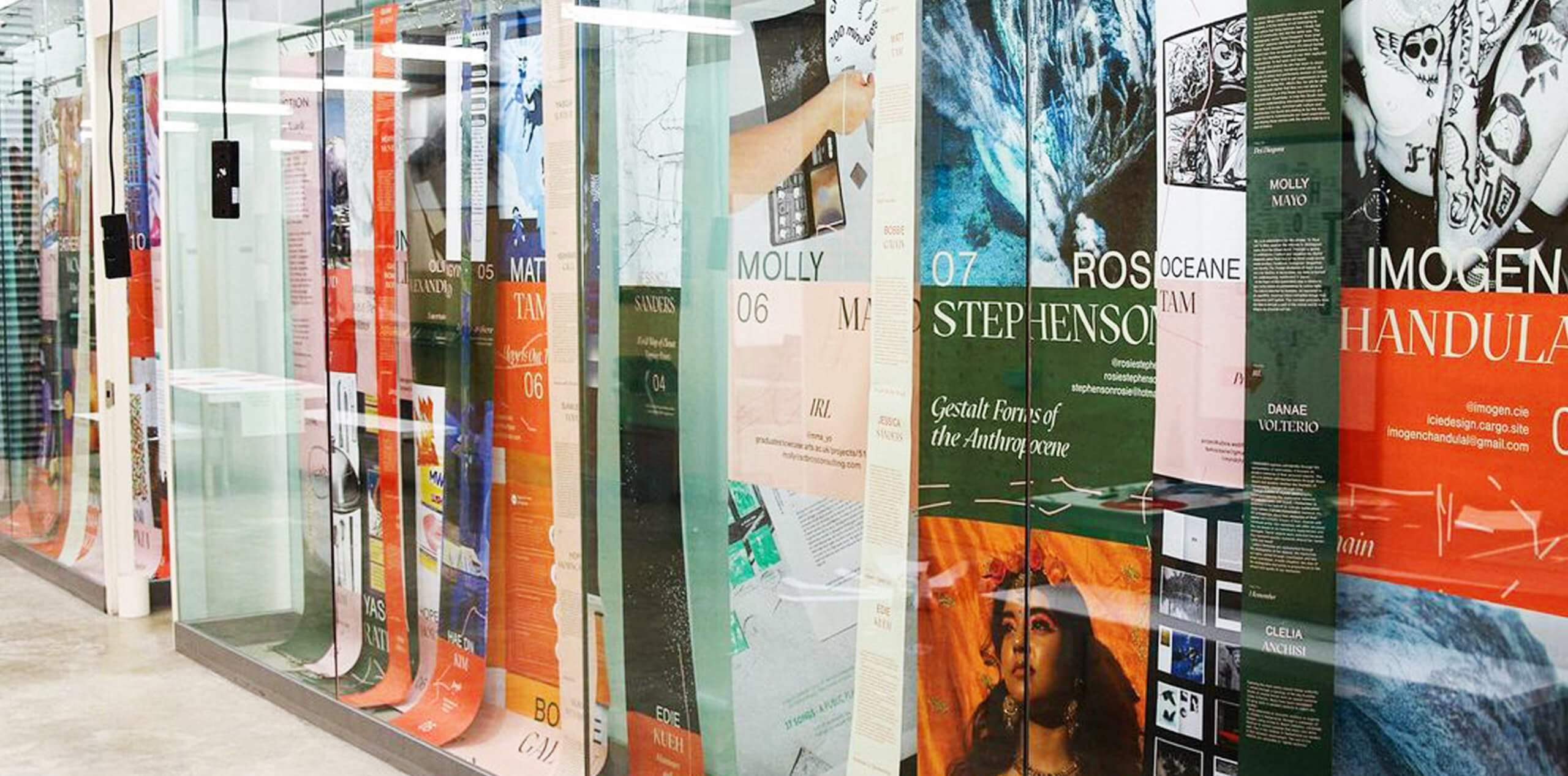Abbie Lilley and Lili Phillips founded Nearly Studio after working together during their final term studying Graphic Communication Design (GCD) at Central Saint Martins (CSM). Collaboration not competition is fundamental to their practice. They both believe in working in a supportive but honest way that pushes them to produce stronger work, which is evident from their well-considered and brilliantly crafted portfolios. Their work has an emphasis on editorial, printed matter and visual identities and they have continued to collaborate since graduating in 2020.
Abbie and Lili’s transition from students to starting their careers in the design industry, like most other recent graduates, was affected by the current pandemic. A positive they managed to find amidst all the disruption was the need to be resilient and responsive to change. They took the opportunity to adapt and shifted focus to produce both digital and printed outcomes, which propelled their creative abilities as designers forward and presented them with new opportunities. With the loss of their physical studio space, they came up with the idea for a digital community and exhibition space to showcase the work of their CSM class of 2020. They created a non-hierarchical platform to view, not only the final projects, but also a place to share the conceptual thought processes involved in creating those projects. They assembled a team of six other students located across the world and, in one week, built a website and supporting 300-page publication. The GCD2020 project caught the attention of the design world and was featured on It’s Nice That, Creative Boom and AIGA Eye on Design. As they tell us, “we saw this time as an opportunity to bring a fresh approach to what a digital space can be; building a platform to lean on each other, share our work in progress, and to keep the studio conversations alive amid isolation—this was the birth of Nearly.”

Abbie and Lili are both naturally drawn to working with print, an interest that continues to inform their practice whilst moving between digital and analogue methods. Another response to Covid-19, was typographic publication ‘Work in Type’, an experimental print project that aims to kick against the anxiety inducing news headlines surrounding the pandemic. The reimagined newspapers Nearly created showcased confident, experimental and playful type.

Nearly have also successfully created a social media presence for sharing work and gaining new opportunities. After being approached on Instagram by members of the curation team for ‘London Grads Now’, they created the visual identity for the alternative ‘degree show’ an exhibition held at the Saatchi Gallery in London. The identity they created used the geographic footprint of each of the participating universities as a design tool to create colourful, geometric patterns. Working fluidly across various communications, these shapes reflect the studio spaces students lost access to during the pandemic. This was a large scale, highly collaborative project and an unforgettable experience.
Abbie is currently working as a Creative Assistant at Yuck Ltd in London and Lili is interning at Pentagram NYC under Eddie Opara. Around their busy schedules they continue to collaborate on Nearly projects in their spare time and at weekends. We look forward to seeing what the future holds for the ambitious new design duo.

We caught up with Abbie and Lili to find out more about the benefits of creative collaboration, working on a visual identity project for the Saatchi Gallery and their advice for current students.
Where did you both study and what do you know now that you wish you’d known when you started your design course?
We both studied BA Graphic Communication Design (GCD) at Central Saint Martins (CSM) and graduated in July 2020. We spent the majority of our three years in the same class as each other, but it was only in the final term of third year that we worked as a duo. This collaboration, Nearly, began as an experimental publishing platform, but is now the name of our collaborative studio.
Reflecting on our time at CSM, we wish we had connected earlier. Our studio tutors had been suggesting we collaborate for a while, but it took us months to find the confidence to start the initial conversation.
So, in answer to your question, we truly wish we had the courage to risk comfort and safety for a chance to collaborate sooner.
How did the London Grads Now project with the Saatchi Gallery come about?
Nearly were approached on Instagram by CSM MA students (and part of the curation team), Mazzy-Mae Green and Greta Voeller, to work on the exhibition identity for the reopening of the Saatchi Gallery, ‘London Grads Now.’
Saatchi kindly provided their space to facilitate a showcase of works by over 250 graduating students from the class of 2020, who, like us, had their crucial degree shows cancelled or postponed. This highly-collaborative, student-led exhibition, was a natural continuation of Nearly’s practice.


Tell us a bit about the process of working on the London Grads Now project, where you got your inspiration and any learning curves.
‘London Grads Now.’ is a collaboration we shall not forget. Working with such a prestigious gallery taught us invaluable design and life skills—from pitching to invoicing. And not only was it our first freelance job as design graduates, but it was a dream client.
The ‘London Grads Now.’ visual language serves as a celebration; an ode to our invaluable studio spaces that were lost during the pandemic.
Our visual identity was heavily influenced by the art of cartography – employing geographical maps (from each of the participating universities) as a design tool. The supporting colour palette is rich, diverse and confident, mirroring the work on display.
Pairing colours with maps allowed for a dynamic identity. Appearing on flyers, gallery walls, outdoor banners and digital material, we were able to create varying combinations that adapted to its environment. For example, the introductory texts on the exhibition walls were abstracted to allow the work to take centre stage.
What top tips would you give to current design students or women considering a career in the design industry?
- Start a social media presence. I (Lili) encouraged Abbie to start a design Instagram account (@by.abbielilley) only a few months ago now. But I have had my design account (@liliphillipsgraphics) since A-Levels, and it’s been a great way to articulate my thoughts, share my work in progress and connect with other artists. Plus, there is such joy in seeing personal growth—if you look back on your work and find yourself cringing, good news, you’re evolving.
- Learn a new skill, avoid trends and lose your ego. As two predominantly print-based students stuck in isolation, we were forced to adapt. Our outputs shifted online, and we found a new appreciation for digital spaces. Being uncomfortable taught us our most valuable lessons.
- Collaborate, not compete. This was one of Nearly’s first declarations. At the heart of our practice, lies participation and honest discourse. Sure, we are supportive of one another, but we are also unafraid of being challenged. Working with like-minded individuals is fantastic. But working with like-minded individuals who you can bicker with is best. It’s what makes us, and our projects, stronger.

Has the Covid-19 pandemic impacted your careers and how have you managed this?
We were part of a unique collective of students, facing uncertainty as to how and when we were going to complete our degrees. We saw this time as an opportunity to bring a fresh approach to what a digital space can be; building a platform to lean on each other, share our work in progress, and to keep the studio conversations alive amid isolation—this was the birth of Nearly.
Covid-19 undoubtedly impacted our transition from students to graduates. However, we became resilient and responsive, producing a body of work that is reflective of the times and of our individual identities as designers.
From sustaining our platform day-to-day, to producing an alternate online degree show and accompanying publication in a week – we used every resource available (including one another) to showcase the multidisciplinary approaches on our course that continue to push the parameters of what design is.
As mentioned, we are two (slightly) print-obsessed designers, so Nearly’s outputs have naturally drifted between printed matter and digital deliveries. Of course, lockdown made this more difficult, but we utilised online services where possible. (We printed the first and second run of our typographic publication, ‘Work in Type’, with ‘Newspaper Club’.)
We are at the beginning of our careers, so currently can’t predict the long-term effects of the pandemic. For now, we realise we are in a fortunate position where we are both employed by design studios and continue to work together (Nearly) on the weekends.
Do you have any female role models or mentors who have shaped your career?
Absolutely! Throughout our time working together, there have been a number of individuals and studios that we often refer to. Here are a few:
- Caterina Bianchini aka ‘Studio Nari’. We love the bold and charismatic approach she takes, not only with colour and form, but through typographic application. After attending a talk from her at D&AD headquarters last year, I (Abbie) finally got around to reading “Design as Art” by Bruno Munari (a book she highly recommended), and it has most certainly altered our design practice.
- Jessica Walsh. An iconic figure in the design industry. As well as her confident creative direction, her response to the lack of female leadership design roles, is incredibly empowering.
- Kira Salter. Our university tutor, life advisor and all-round powerhouse. After all, without Kira, we would not be working together.

Which women designers would be on your dream list to work or collaborate with and why?
Margot Leveque, Elana Schlenker and Chloe Scheffe.
We admire Margot’s rigorous working process, stating that design doesn’t, and can’t always happen overnight. Elana’s striking use of colour is evident in everything she does. We would love to know how she does it! And Chloe Scheffe, for changing the publishing game—using analogue processes to challenge traditional editorial design.
